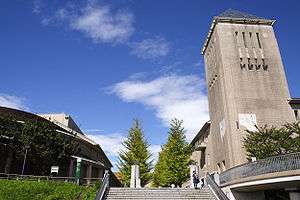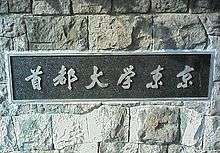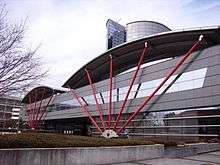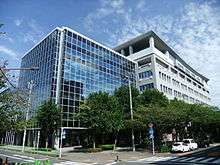Tokyo Metropolitan University
| 首都大学東京 | |
 | |
| Motto | To pursue the vision of an ideal human society in a metropolis |
|---|---|
| Type | Public |
| Established | 1949 (reformed in 2005) |
Academic staff | 695 full-time |
| Students | 8,538 |
| Undergraduates | 6,583 |
| Postgraduates | 1,955 |
| 454 | |
| Location |
Hachioji, Tokyo, Japan 35°37′00″N 139°22′38″E / 35.616667°N 139.377222°E |
| Campus | Urban |
| Colours | Black and blue gray |
| Website |
www |
 Japan Tokyo Metropolis | |
| As of May 1, 2008[1] | |
Tokyo Metropolitan University (首都大学東京 Shuto Daigaku Tōkyō), often referred to as TMU, is a Public Research University in Japan.
Origin
The origin of Tokyo Metropolitan University was Prefectural Higher School, under the old system of education, established by Tokyo Prefecture in 1929 as the third public higher school. The School was modeled on Eton College, with three years of advanced course and four years of regular course.
The seven-year system had an advantage to assure the entrance to Imperial universities at the age of Middle School, and the typical passway for academic elites before the end of Pacific War was to enter Tokyo First Middle School, proceeding First Higher School and Tokyo Imperial University.
Since the jurisdiction control of Tokyo First Middle School and First Higher School were different, however, Tokyo First Middle School attempted to originally establish the prefectural higher school, whereas the other Middle Schools opposed to the said attempt. Prefectural Higher School was established in 1929 locating in the same site of Tokyo First Middle School, as a result of the opposition.

In 1932, Prefectural Higher School was relocated to 1–1–1 Yakumo, Meguro and became known one if the best higher schools with First Higher School. As the reign of Tokyo Metropolis was enacted in 1943, Prefectural Higher School was renamed to Metropolitan Higher School.
After the reform of the educational system in 1949, Tokyo Metropolitan University (former) was established as a research university consisting of three faculties, namely Faculty of Humanities, Faculty of Science and Faculty of Technology; three years of advanced course was reorganised to Senior High School affiliated to Tokyo Metropolitan University, whereas four years of regular course was restructured to Liberal arts college and other faculties. Five Prefectural Colleges, namely Tokyo Prefectural College of Technology, Tokyo Prefectural College of Science, Tokyo Prefectural College of Machine Industry, Tokyo Prefectural College of Chemical Industry and Tokyo Prefectural College of Women were also merged to Tokyo Metropolitan University. In 1957, Faculty of Law and Economics was separated from Faculty of Humanities, and reorganised as Faculty of Law and Faculty of Economics in 1966.
As expanding its organisation, the university was relocated to 1–1–1 Minami-Osawa, Hachioji in 1991.
The university signed the student exchange agreement with University of Vienna in 1997.
Tokyo Metropolitan University was reformed in 2005 by integrating three metropolitan universities and one junior college: Tokyo Metropolitan University (東京都立大学 Tōkyō Toritsu Daigaku), Tokyo Metropolitan Institute of Technology (東京都立科学技術大学), Tokyo Metropolitan University of Health Sciences (東京都立保健科学大学), and Tokyo Metropolitan college (東京都立短期大学), although its English name for the university has not changed since 1949.
History
The following history includes the former institution of Tokyo Metropolitan University.
- 1949 – Tokyo Metropolitan University was established with three faculties, namely Humanities, Science and Technology
- 1953 – Master's courses of Anthropology, Social Science, Natural Science and Technology were set up
- 1955 – Doctoral courses of Anthropology, Social Science, Natural Science and Technology were set up
- 1957 – Faculty of Law and Economics was set up
- 1966 – Faculty of Law and Economics was reorganised as Faculty of Law and Faculty of Economics
- 1977 – Centre of Metropolitan Study was set up
- 1994 – Centre of Metropolitan Study was reorganised as Institute of Metropolitan Study
- 1996 – Master's course of Metropolitan Science was set up
- 1998 – Doctoral course of Metropolitan Science was set up
- 1991 – The campus was transferred from Meguro to Minami-Osawa
- 2003 – Institute of Social Science launched to provide MBA course (Business school)
- 2005 – Institute of Social Science launched to provide LLM course (Law school)
- 2005 – Tokyo Metropolitan University was reformed with integrating three metropolitan universities and one junior college, which consists of 4 faculties, 7 divisions with 21 courses as well as 6 graduate schools (the organisation took over the former one) with 36 majors
- 2006 – Faculty of System Design opened the course of industrial art, and institutes were reorganised
- 2008 – Faculty of Urban Environment Sciences launched the course of nature- and culture- based tourism, and Graduate School of Urban Environmental Sciences launched the major of tourism science
- 2009 – Faculty of Urban Liberal Arts launched the course of economics
- 2010 – Graduate School of System Design launched the major of industrial art
- 2011 – Tokyo Metropolitan University (former) was closed
- 2014 – Bangkok Office was set up in Bangkok, Thailand[2]
- 2016 – Business School will be transferred from Shinjuku Satellite Campus to Marunouchi Satellite Campus with launching the course of Master of Finance
University reform
In later 1990s, Government and local municipalities facilitated to reform the administrative scheme and financial management in line with economic bubble burst and financial difficulties due to Japan's progressive low birthrate and longevity. As a part of the said administrative and financial reform, social interest grew on restructuring national and public universities to independent administrative agencies with consolidating them. Tokyo Metropolitan University was also planned by Tokyo Metropolitan Government to be consolidated with aforementioned three metropolitan universities and one junior college.

As a result of Tokyo gubernatorial election in April 2003, Shintaro Ishihara was re-elected as Governor of Tokyo, holding up a promise "I will establish a revolutionary university", and consequently the original restructure plan was significantly and rapidly changed, in terms of the organisation of faculties, course structure, etc. During this process, many faculty staff left the university for making strong protest against the reform.
Faculties (undergraduate)
- Urban Liberal Arts
- Humanities and Social Sciences
- Law and Politics
- Business Administration
- Science and Engineering
- Urban Environmental Sciences
- System Design
- Health Sciences
Graduate schools
- Humanities
- Social Sciences
- Science and Engineering
- Urban Environmental Sciences
- System Design
- Human Health Sciences
Campuses
- Minami-Osawa Campus (Main campus)
- Hino Campus (Faculty of System Design and Graduate School of System Design)
 Hino campus
Hino campus - Arakawa Campus (Faculty of Health Sciences and Graduate School of Human Health Sciences)Arakawa campus
- Harumi Campus (Law School)
 Harumi campus
Harumi campus - Marunouchi Satellite Campus (Business School)
Facilities
- Computer Centre and Information Processing Facilities
- Science and Technology Research Facilities
- The Makino Herbarium
- International House
- Ogasawara Field Research Station
- External Facility in Fujimi-kogen Highlands (two-story log-house)
- Bangkok Office
Research Centres
Lecturers of the university has been all highly regarded in their respective fields, and the standard of the research carried out by each of them has been considered as extremely high. In line with this, research groups that produce outstanding results and have the potential to become international research hubs, or those working in unique fields that are aligned with the university's mission, are designated as "research centres" and given support by the university.
- Research Centre for Space Science (Director: Prof. Takaya Ohashi)
- Research Centre for Genomics and Bioinformatics (Director: Prof. Koichiro Tamura)
- Research Centre for Artificial Photosynthesis (Director: Prof. Haruo Inoue)
- Research Centre for Gold Chemistry (Director: Prof. Masatake Haruta)
- Research Centre for Language, Brain and Genetics (Director: Prof. Hiroko Hagiwara)
- Research Centre for Water System Engineering (Director: Prof. Akira Koizumi)
- Research Centre for Community Centric Systems (Director: Prof .Toru Yamaguchi)
- Research Centre for Child and Adolescent Poverty Overview (Director: Prof. Aya Abe)
International Partner Institutions
The university has concluded agreements with the overseas educational institutions with the aim of promoting international cooperation in education and research as well as student exchange.
Asia
- Mahidol University
- Thammasat University
- King Mongkut's University of Technology Thonburi
- Chulalongkorn University
- Universiti Teknologi Malaysia
- University of Malaya
- Universiti Putra Malaysia
- University Kebangsaan Malaysia
- Indonesia University of Education
- University of Indonesia
- BINUS University
- College of Liberal Arts and Social Sciences, City University of Hong Kong
- Chung-Ang University
- Hanyang University
- University of Seoul
- Kumoh National Institute of Technology
- Sookmyung Women's University
- Incheon National University
- Chonnam National University
- Hue University
- Water Resources University
- Hue University of Medicine and Pharmacy
- Northeastern University
- International Cultural Exchange School of Fudan University
- Capital Normal University
- Jinlin University
- South China University of Technology
- Chinese Culture University
- National Taiwan Normal University
- National Chung Cheng University
- Taipei Municipal University of Education
- National Tsing Hua University
- Fu Jen Catholic University
- National Dong Hwa University
- National Sun Yat-sen University
- Royal Melbourne Institute of Technology
- Edith Cowan University
- Macquarie University
- Institute of Continuing & TESOL Education, University of Queensland
- University of Western Sydney
- University of Woolongong
- The University of Newcastle
North America
- Royal Roads University
- University of Waterloo
- The University of Western Ontario
- Memorial University of Newfoundland
- University of Manitoba
- Saint Mary's University
- University of Regina
- Murray State University
- Eastern Washington University
- University of California, Riverside, Extension
- University of Wisconsin-Green Bay
- Georgia Institute of Technology
Europe
- Oxford Brookes University
- The School of Oriental and African Studies, University of London
- Bangor University
- University of Hull
- University of Leicester
- The University of Birmingham
- The University of York
- The University of Nottingham
- The University of Aberdeen
- University of Northumbria at Newcastle
- Keele University
- University of Portsmouth
- Fachhochschule Kaiserslautern – University of Applied Sciences
- Koblenz University of Applied Science
- University of Bayreuth
- Lille 1 University
- Paris-South 11 University
- Rennes 2 University
- The International Organization for Research and Education on Mechatronics
- Cardenal Cisneros University College, Alcala University
- The University of Alcala
- University of A Coruña
Academic reputation
| University rankings | |
|---|---|
| Global | |
| Times[3] | 401–500 |
| QS[4] | 491–500 |
| Asia | |
| Times[5] | 33 |
| QS[6] | 96 |
Although its small size and young history in contrast to national universities and several leading private universities, the university has been one of the most reputable institutions in Japan. According to the Times Higher Education World University Rankings, it ranks 7th in 2014–2015 among 781 universities in Japan, behind renowned national universities, namely University of Tokyo, Kyoto University, Tokyo Institute of Technology, Osaka University, Tohoku University and Nagoya University. The university received the highest score of 100.0 for "citations.”
In 2012, Prof. Masatake Haruta was selected as a Thomson Reuters Citation Laureate as a possible winner of the Nobel Prize for his "independent foundational discoveries of catalysis by gold."[7]
References
- ↑ "Guide to Tokyo Metropolitan University: 大学案内2010英語版" (PDF). May 2008. Retrieved 2009-09-27.
- ↑ "Information :: TMU has established its first overseas office in Bangkok.". www.tmu.ac.jp. Retrieved 2016-03-13.
- ↑ "World University Rankings 2016-2017". Times Higher Education. 2016. Retrieved October 22, 2016.
- ↑ "QS World University Rankings 2018". Quacquarelli Symonds Limited. 2017. Retrieved June 21, 2017.
- ↑ "Asia University Rankings 2017". Times Higher Education. 2017. Retrieved 17 August 2017.
- ↑ "QS University Rankings: Asia 2016". Quacquarelli Symonds Limited. 2016. Retrieved July 11, 2016.
- ↑ "Information :: Professor Masatake Haruta has been presented with a certificate as a 2012 Thomson Reuters Citation Laureate in the annual pre-Nobel "Thomson Reuters Predicts Nobel Laureates" event.". www.tmu.ac.jp. Retrieved 2016-03-16.
External links
| Wikimedia Commons has media related to Tokyo Metropolitan University. |
Coordinates: 35°37′00″N 139°22′38″E / 35.61667°N 139.37722°E